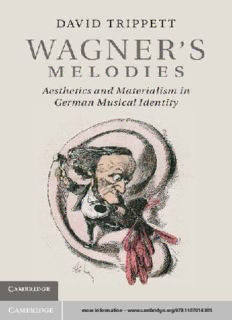
Wagner's Melodies: Aesthetics and Materialism in German Musical Identity PDF
Preview Wagner's Melodies: Aesthetics and Materialism in German Musical Identity
more information – www.cambridge.org/9781107014305 ’ Wagners Melodies Sincethe1840s, critics havelambastedWagner for lacking theability tocomposemelody.Butforhim,melodywasfundamental–“music’s onlyform.”Thisincongruitytestifiestothesurprisingdifficultiesduring thenineteenthcenturyofconceptualizingmelody.Despiteitsindispen- sableplaceinopera,contemporarytheoristswereunableeventoagree onadefinitionforit,letaloneformulateastablebasisforteachingit. InWagner’sMelodies,DavidTrippettre-examinesWagner’scentral aesthetic claims. He places the composer’s ideas about melody in the contextofthescientificdiscourseofhisage:fromtheemergenceofthe Natural Sciences and historical linguistics to sources about music’s stimulationofthebody,andinventionsfor“automatic”composition. Interweaving a rich variety of material from the history of science, music theory, criticism, private correspondence and court reports, Trippett uncovers a new and controversial discourse that placed melody at the apex of artistic self-consciousness, and generated problemsofurgentdimensionsforGermanmusicaesthetics. davidtrippett isLecturerinMusicattheUniversityofCambridge and a Fellow of Christ’s College. His work on Wagner, the history of aesthetics,andtheoriesoftechnologyhasappearedinvariousacademic publications, and has earned him the Alfred Einstein Award of the American Musicological Society, and the Donald Tovey Memorial Prize of the University of Oxford. He has served as guest editor of Musiktheorie,andiseditorandtranslatorofCarlStumpf’sTheOrigins ofMusic(2012).Healsoperformsregularlyasacollaborativepianist. ’ Wagner s Melodies Aesthetics and Materialism in German Musical Identity david trippett cambridge university press Cambridge,NewYork,Melbourne,Madrid,CapeTown, Singapore,SãoPaulo,Delhi,MexicoCity CambridgeUniversityPress TheEdinburghBuilding,CambridgeCB28RU,UK PublishedintheUnitedStatesofAmericabyCambridgeUniversityPress,NewYork www.cambridge.org Informationonthistitle:www.cambridge.org/9781107014305 ©DavidTrippett2013 Thispublicationisincopyright.Subjecttostatutoryexception andtotheprovisionsofrelevantcollectivelicensingagreements, noreproductionofanypartmaytakeplacewithoutthewritten permissionofCambridgeUniversityPress. Firstpublished2013 PrintedandboundintheUnitedKingdombytheMPGBooksGroup AcataloguerecordforthispublicationisavailablefromtheBritishLibrary LibraryofCongressCataloguinginPublicationdata Trippett,David,1980– Wagner’smelodies:aestheticsandmaterialisminGermanmusicalidentity/DavidTrippett. p. cm. Includesbibliographicalreferencesandindex. ISBN978-1-107-01430-5 1. Wagner,Richard,1813–1883–Criticismandinterpretation. 2. Music–19th century–Philosophyandaesthetics. 3. Melody. I. Title. ML410.W13T77 2013 782.1092–dc23 2012034001 ISBN978-1-107-01430-5Hardback CambridgeUniversityPresshasnoresponsibilityforthepersistenceor accuracyofURLsforexternalorthird-partyinternetwebsitesreferredto inthispublication,anddoesnotguaranteethatanycontentonsuch websitesis,orwillremain,accurateorappropriate. For Paula Contents Listofillustrations [pageviii] Acknowledgements [x] Anoteonpresentation [xii] Listofabbreviations [xiii] Introduction [1] 1 Germanmelody [12] 2 Melodielehre? [69] 3 Wagnerinthemelodicworkshop [130] Excursus:Bellini’sSinnlichkeitandWagner’sItaly [182] 4 Hearingvoices:WilhelmineSchröder-Devrientandthe Lohengrin“recitatives” [198] 5 Vowels,voices,and“originaltruth” [280] 6 Wagner’smaterialexpression [330] Epilogue:Turningoffthelights [393] AppendixA:BooksonlanguageinWagner’sDresdenlibrary [399] AppendixB:BooksonlanguageinWagner’sWahnfriedlibrary [402] Selectbibliography [408] Index [439] vii Illustrations 1.1 Hagesandros,Athenedoros,andPolydoros[Laocoönandhis sons].Marblecopyoftheoriginal,fromca.200bc;discovered intheBathsofTrajanin1506.MuseiVaticani,Museo Pio-Clementino,Octagon,LaocoönHall. [page41] 1.2 TheodorGéricault,AStudyofSeveredLimbs(1818–19). [56] 1.3 ThemodestwavylinetoindicateBrangäne’sscream inWagner’sOrchesterpartiturforTristanundIsolde, NAAIIIh7,p.235. [65] 2.1 EmilGrimm,MusikalischerWahnsinndes19tenJahrhundert, (1851).MuseumlandschaftHessenKassel. [73] 2.2 TheinternalmechanismforDiederichNicolausWinkel’s Componium(1821). [97] 2.3a–d FriedrichAugustKanne’sillustrationsofmelodicwave motioninimitationofwater,AllgemeinemusikalischeZeitung 68(1821),537–38. [106] 3.1 Berlioz’stwo-pageentryintheStammbuchofMarievonSayn- Wittgenstein,(1855).Goethe-undSchiller-Archiv,Weimar(GSA 60/Z170). [177] 3.2 FrancescoHayez,MeditationsontheHistoryofItaly/Meditations ontheOldandNewTestament(1850),GalleriaCivicaD’Arte ModernaEContemporaneaDiPalazzoForti. [191] 3.3 AntonioCanova,TheThreeGraces:Aglaia,Euphrosyne,and Thalia(1815–17).NationalGalleryofScotland,Edinburgh,and VictoriaandAlbertMuseum,London. [195] 4.1a–c Liszt’sconductingscoreofLohengrin,Goethe-und Schiller-Archiv,Weimar(GSA60/Z19). [236] 4.2a–b Wagner’sconductingscoreforperformancesofLohengrinin FrankfurtamMainonSeptember12–17,1862. Universitätsbibliothek,FrankfurtamMain(MusWf22). [248] 4.3a–b Édouard-LéonScottdeMartinville,“FixationGraphiquede laVoix”(1857),Sociétéd’encouragementpourl’industrie nationale,archives. [258] viii
Description: